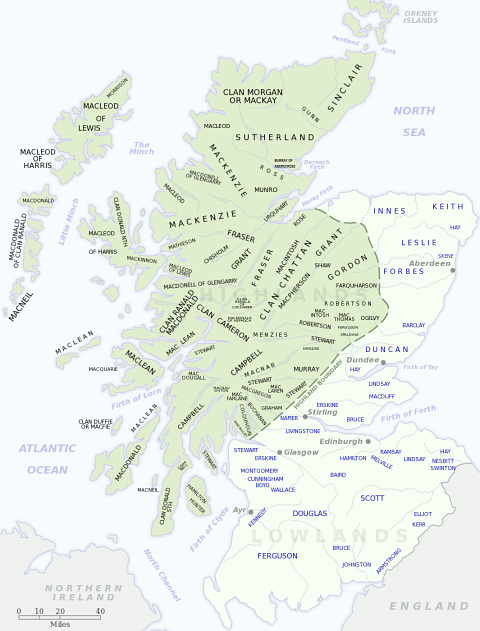
Motto: Virtutem coronat honos (Honour crowns virtue)
Historic Seat: Drummond Castle
District: Perthshire
Associated Surnames: Brewer, Cargill, Doig, Grewer, MacCrouther, MacGrewar, MacGrowther, MacGrude, MacRobbie, MacRobert, MacRobie, Magruder
Associated Tartans:
Early Drummond Genealogy and History:
(Excerpt from "The Scottish Clans and Their Tartans", James Grant, 1906)
Various genealogists state that the traditional origin of the Drummonds is taken from Maurice, son of George, a younger son of Andrew, King of Hungary, who is said to have accompanied Edgar Atheling, the rightful heir to the English throne; but the ship in which the latter with his mother Agatha and his sisters Margaret and Christian were embarked in, to sail back to Hungary, was overtaken by a storm, and wrecked at the place on the Forth, now called St. Margaret's Hope, in honour of the eldest princess, who became the Queen of Malcolm III, from whom Maurice obtained a grant of the lands of Drummond, or Drymen, in Stirlingshire, the estate from whence his family took their name.
Queen Margaret, says Douglas, gave him one of her maids of honour in marriage, and that from their son Malcolm all the Drummonds in Scotland are descended.
There is every probability that at an early state of their history the Drummonds had reached opulence and influence, as Malcolm Beg, so called from his low stature, sixth of the family, married Ada, daughter of Malduin, Earl of Lennox, by Beatrice, daughter of Walter, the Lord High Steward.
Two of his grandsons became the prisoners of Edward I, and the eldest, Sir John, had, under compulsion, to swear fealty to the latter, and serve in his army against France: but his eldest son, Sir Malcolm Drummond, who married a daughter of Graham of Kincardine, was loyal to Bruce, and after Bannockburn1 received from him certain lands in Perthshire.
His grandson, Sir John, married Mary Montifex, who brought him Cargill, Stobhall, and other places. He had a bitter feud with the Menteiths of Ruskie, in which his kinsman, Bryce Drummond, was slain in 1330, and in pursuance of which he was accused of having slain three of the Menteiths, in compensation for which he was compelled to resign Roseneath. After this he retired to his lady's seat of Stobhall. Their daughter Annabella became Queen of Robert III.
Near the seat of Lord Ancaster in Muthil, still stand the ruins of the stronghold of this ancient race.
"How the Drummonds parted with the lands of Drymen has been forgotten," says Nimmo. Balfrone had been bestowed upon Thomas, a younger brother of the chief, who gave the patronage of the church then to the Abbey of Inchaffry, before 1305. "The Barony of Drummond, which still goes by that name, had before 1488 belonged to the first Earl of Lennox, and when this nobleman had, in 1489, attempted to revenge the death of James III, he lost the barony by forfeiture. It was ten years after bestowed upon the first Lord Drummond, who, though ennobled by James, had joined the insurgents. It remained in the Drummond of Perth Family 130 years, when in 1630 John, second Earl of Perth, sold it to William Earl of Menteith."
John, first Lord Drummond, died in 1519, and was succeeded by his son David, second Lord, who died in 1571, leaving two sons, Patrick, third Lord, and James, created Lord Maderty, ancestor of the Viscounts Strathallan. Patrick, third Lord Drummond, had two sons, James, fourth Lord, who was created Earl of Perth, 1605, and dying in 1611, was succeeded by his brother John, second Earl, who was succeeded in his turn in 1662 by his son James, third Earl. This Earl left two sons, James, fourth Earl of Perth, and John, created Earl of Melfort, 1686.
James, fourth Earl of Perth was Lord Chancellor of Scotland, and followed the fortunes of the Stuarts, being created by James VII Duke of Perth, K.G.2 He died at St. Germains in 1716, and was interred in the Scottish College at Paris. His eldest son, James, second titular Duke, was out in the rising of 1715, and was attainted. He died 1720, being succeeded by his sons James and John, third and fourth titular Dukes, who both died unmarried. The fifth and sixth titular Dukes were younger sons of the first. The Earldom of Perth then went to the Melfort branch of the family (see above.)
John, first Earl of Melfort, followed the fortunes of the Stuarts, and was created Duke of Melfort by Louis XIV of France. He died 1715, and was succeeded by his son John, second Duke, who died 1754. His son James, third Duke, had three sons - James, fourth Duke, Charles Edward, fifth Duke, and Leon, who was father of George Drummond, who was restored by Queen Victoria to the Scottish honours of his family as fourteenth Earl of Perth and sixth Earl of Melfort in 1853. He died in 1902, being succeeded in the Melfort titles by his daughter, Lady Marie Drummond, and in the Perth titles by his distant kinsman, William eleventh Viscount Strathallan, the descendant of James, Lord Maderty, second son of the second Baron Drummond.
(End excerpt)
Next page: Clan Dundas
Footnotes:
1 The Battle of Bannockburn (1314): The Battle of Bannockburn was fought on 23 and 24 June 1314, was a victory of the army of Robert the Bruce, King of Scots, over the army of King Edward II of England in the First War of Scottish Independence. Read more about the Battle of Bannockburn at Wikipedia.
2 K.G.: Knight, The Most Noble Order of the Garter. Read about the Order of the Garter at Wikipedia.

Distribution of Scottish clans and families
View larger map at Wikimedia Commons

Browse the Clan Drummond Tartan Collection with home decor, personal accessories, crafting, paper products, and more.

Browse the Clan Drummond Dress Tartan Collection with clothing, home decor, accessories, electronics cases, and more.

Clan Drummond Postcard: Digitally cleaned and enhanced vintage illustration with tartan border.